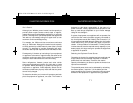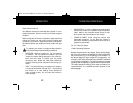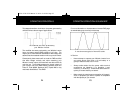
17
16
OPERATION
OPERATION
connecting the ground, make certain that the invert-
er is turned off. Operating the inverter without
properly grounding it may result in electrical shock.
7. Turn the inverter ON (I). Check the Bar Graph Meter
on the front panel. The Voltage Bar Graph should
read between 11 and 14 volts depending on the volt-
age of the power source. If the reading is not within
this range, check the voltage of the power source
and the terminal connections on the power source
and the inverter to make sure they are secure.
Neither the High Temperature or Over Load LED
Indicators should be illuminated.
8. Confirm that the equipment or appliance to be oper-
ated is turned off. Plug the equipment or appliance
into one of the two AC receptacles on the front panel
of the the inverter.
9. Turn the inverter to the ON (I) position. Turn on the
equipment or appliance.
Note:
• The audible alarm may make a momentary “chirp”
when the inverter is turned OFF (O). The same alarm
may also sound when the inverter is being connect-
ed to or disconnected from the 12 volt power source.
Again, this is normal.
• The use of an extension cord from the inverter to the
Note:
• Loose connections can result in a severe decrease in
voltage which may cause damage to the wires and
insulation.
• Failure to make proper connection between the
inverter and the power source will result in
reverse polarity. Reverse polarity will blow the
internal fuses in the inverter and may cause per
-manent damage to the inverter. Damage
caused by reverse polarity is not covered
under the Whistler warranty.
• Making the connection between the Positive (+) ter-
minals may cause a spark as a result of current flowing
to the capacitors in the inverter. This is a normal
occurrence. Due to the potential for sparking, how-
ever, it is extremely important that both the inverter
and the 12 volt battery be well removed from any pos-
sible source of flammable fumes or gases.
Failure to heed this warning could result in fire or
explosion.
6. Run a ground from the Ground Lug Terminal at the
rear of the inverter to a proper grounding point using
the shortest practical length of 18 AWG wire .
Selection of the grounding point will depend on
where you are using the inverter. The ground wire may
be connected to the chassis of your vehicle or to the
grounding system in your boat or to the earth if you
are operating the inverter in a remote location. Before
1250/1750/2750 Manual 3/6/02 2:45 PM Page 19


















